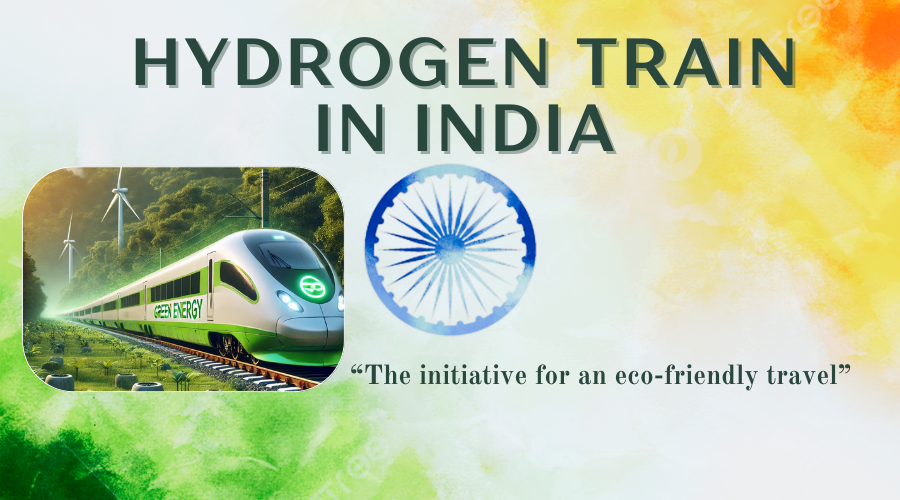
The Hydrogen Train in India is a clear substitute for diesel, fuel cells are used to power electricity and generate water vapour. They are quiet with zero emissions and can utilize existing railway lines without costly electrification. India is set to trial its first hydrogen train in 2025.
India’s First Hydrogen Train is all set to step forward for a zero waste and eco-friendly rail transport. Fuel cells generate electricity in hydrogen trains, exhale only water vapor, creating a good replacement to diesel locomotives. Partially India’s move for renewable mobility, these trains combine the country’s renewable energy goals. Indian railways dynamically reform growth in Hydrogen technology. Indian rail is all set to be reshaped with hydrogen trains for the eco-friendly future in India.
Green Energy Solutions: Through Hydrogen and oxygen Combination Hydrogen trains use fuel cells to power emission-free motors, with lithium-ion batteries storing excess energy for extra power for smoother eco-friendly operation.
Electric power: Hydrogen trains produce electricity through fuel cells, when Hydrogen and oxygen interact to generate electricity. This hydrogen powers the train’s motors, driving its wheels while emitting only water vapor, making it a clean energy solution.
Advanced Energy Storage: Hydrogen trains use lithium-ion batteries for energy storage, capturing excess power from fuel cells and regenerative braking. These batteries provide extra power during high demand, ensuring efficiency, smooth acceleration, and extended range while supporting sustainable, zero-emission rail transport.
The project of Hydrogen Train Manufacturers in India is a game-changer project for sustainable rail transport. Under the "Hydrogen for Heritage" plan 35 eco-friendly trains will launch on heritage and hilly routes, lowering emissions, saving fuel and giving a greener future.
India's Hydrogen Train concept focuses on hydrogen infrastructure and track improvements. Under the "Hydrogen for Heritage" initiative which is worth ₹70 crore per route. This is allocated for ground infrastructure to ensure efficient hydrogen storage, distribution, and fueling, supporting India's shift to sustainable rail transport.
“Hydrogen train in India” implements advanced safety and leak detection, fire safety and high-pressure hydrogen storage. Strict control, planned fueling, and strong safety measures enable reliable travel.
India's initiative of hydrogen trains offer benefits like lower fuel costs and government incentives. Despite this, difficulties include high initial investments - ₹80 crore per train and ₹70 crore per track for development - and selective refueling hubs. These factors demand significant upfront investment for long-term gains.
No Emissions : Hydrogen trains are a game-changer—without emissions, just pure water vapor! They slash carbon footprints, boost air quality, and replace diesel with a quieter, cleaner, and energy-smart ride for a greener, more sustainable future in rail transport.
Eco-friendliness: They contribute to a cleaner environment by eliminating harmful emissions like carbon dioxide, nitrogen oxides, and particulate matter.
Lower Noise : Hydrogen trains are significantly quieter compared to diesel engines.
Minimal-Waste Operation: They can stand for lengthy periods between fill-ups and quick refueling.
Over a Long Range: Hydrogen trains offer a long range, covering extended distances on a single refueling, making them ideal for regional and intercity travel.
Fast Fill-Up : Hydrogen trains feature quick refueling, minimizing downtime and ensuring efficient operations, making them a reliable alternative to diesel-powered rail transport.
Quiet Operation : Hydrogen Fuel trains in India ensure quiet operation, reducing noise pollution, enhancing passenger comfort, and making them ideal for urban and residential areas.
Versatile Application: Hydrogen trains offer versatile applications, operating on non-electrified tracks, serving urban, regional, and long-distance routes without extensive infrastructure upgrades.
Environmental Benefits: The first hydrogen train in India is going to mark a green revolution in rail transport, cutting carbon emissions and eliminating air pollution. Zero-emission technology ensures cleaner air, less fossil fuels, and a sustainable future for eco-friendly mobility.
Zero Emissions: The hydrogen fuel train in India will run without emitting harmful pollutants, releasing only water vapor. By replacing diesel engines, it significantly reduces carbon emissions, improves air quality, and supports India’s shift toward cleaner, more sustainable, and eco-friendly rail transport.
Fuel Saving: The hydrogen fuel train in India optimizes fuel usage by replacing diesel with clean hydrogen energy. Efficient, eco-friendly, money saving rail travel is India’s future.
Initiative First Taken by Germany: Germany was the first to introduce Hydrogen trains in Coradia iLint in 2018. These trains operate on non-electrified routes as a replacement of diesel engines, lowering emissions and supporting the country’s shift toward sustainable, eco-friendly rail transport.
India’s Initiative : India’s first hydrogen train is developing under the "Hydrogen for Heritage" initiative. These eco-friendly trains aim to reduce emissions, enhance sustainability, and operate on heritage and regional rail routes.
North America’s Initiative: North America is advancing hydrogen train initiatives, with Canada launching the first hydrogen-powered train in 2023 and the U.S. developing projects in California. These efforts aim to replace diesel, cut emissions, and promote sustainable rail transport.
Versatile Solution: The hydrogen train in India seamlessly integrates with existing rail infrastructure, eliminating the need for costly electrification. Its versatility allows operation on non-electrified routes, making sustainable transport more accessible while accelerating India's transition to greener, more efficient railway systems.
More Upgradation: Retrofitting hydrogen trains allows existing diesel-powered locomotives to be upgraded with hydrogen fuel technology, reducing costs and infrastructure changes. This innovation accelerates the transition to sustainable rail transport, cutting emissions while utilizing current railway assets for a greener future.
India’s revolutionary step path towards hydrogen-powered trains is more beyond technology; it’s a commitment to a greener future. In preparation for India’s first hydrogen train trial in 2025, this fundamental step toward decreasing carbon footprints and modernizing railway infrastructure without heavy reliance on electrification. “Hydrogen Train in India” this is not just a possibility — it’s a necessity for a sustainable, energy-efficient transport system. Fulfillment of this initiative could transform the green movement in India’s action to set an inspiration for global change.